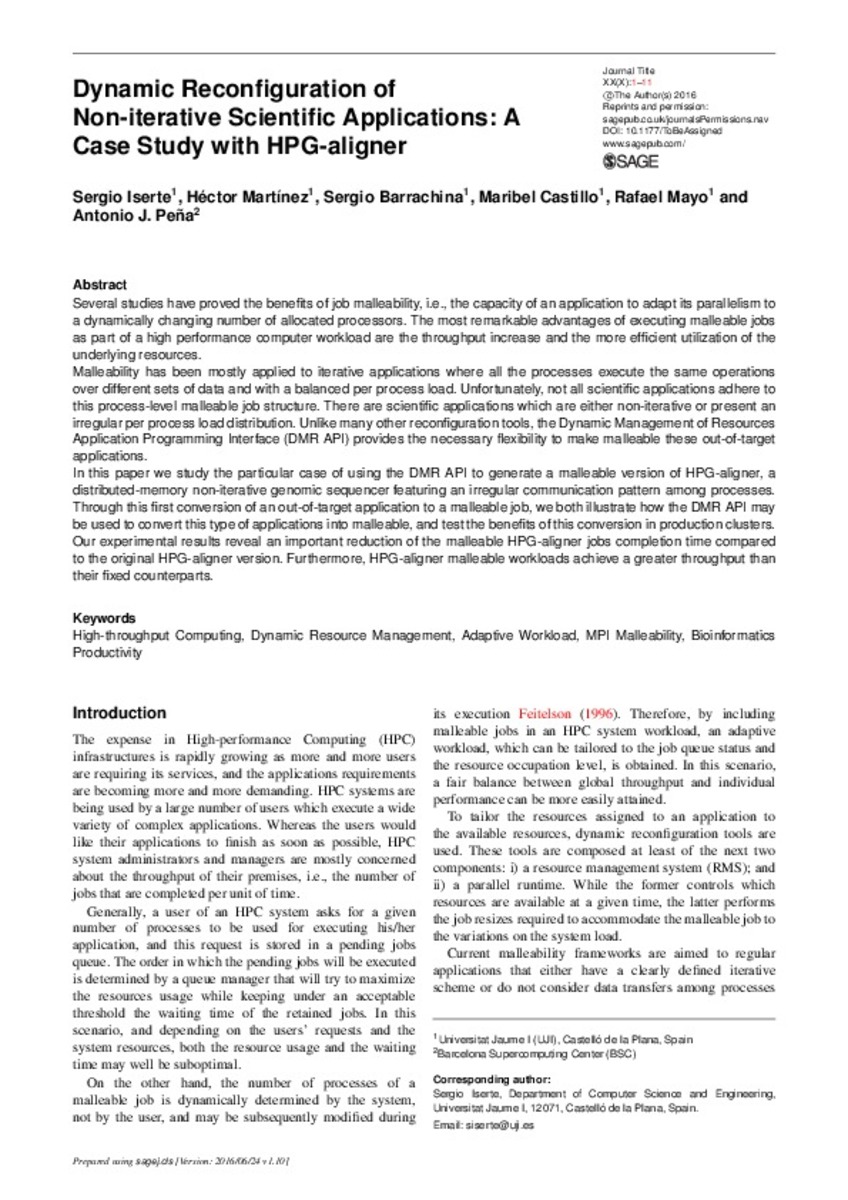Mostrar el registro sencillo del ítem
Dynamic reconfiguration of noniterative scientific applications A case study with HPG aligner
| dc.contributor.author | Iserte, Sergio | |
| dc.contributor.author | Martínez Pérez, Héctor | |
| dc.contributor.author | Barrachina Mir, Sergio | |
| dc.contributor.author | Castillo Catalán, María Isabel | |
| dc.contributor.author | Mayo, Rafael | |
| dc.contributor.author | Peña Monferrer, Antonio J. | |
| dc.date.accessioned | 2018-12-20T07:56:33Z | |
| dc.date.available | 2018-12-20T07:56:33Z | |
| dc.date.issued | 2018-09 | |
| dc.identifier.citation | ISERTE, Sergio, et al. Dynamic reconfiguration of noniterative scientific applications: A case study with HPG aligner. The International Journal of High Performance Computing Applications, 2018, 1094342018802347. | ca_CA |
| dc.identifier.uri | http://hdl.handle.net/10234/178287 | |
| dc.description.abstract | Several studies have proved the benefits of job malleability, that is, the capacity of an application to adapt its parallelism to a dynamically changing number of allocated processors. The most remarkable advantages of executing malleable jobs as part of a high performance computer workload are the throughput increase and the more efficient utilization of the underlying resources. Malleability has been mostly applied to iterative applications where all the processes execute the same operations over different sets of data and with a balanced per process load. Unfortunately, not all scientific applications adhere to this process-level malleable job structure. There are scientific applications which are either noniterative or present an irregular per process load distribution. Unlike many other reconfiguration tools, the Dynamic Management of Resources Application Programming Interface (DMR API) provides the necessary flexibility to make malleable these out-of-target applications. In this article, we study the particular case of using the DMR API to generate a malleable version of HPG aligner, a distributed-memory noniterative genomic sequencer featuring an irregular communication pattern among processes. Through this first conversion of an out-of-target application to a malleable job, we both illustrate how the DMR API may be used to convert this type of applications into malleable and test the benefits of this conversion in production clusters. Our experimental results reveal an important reduction of the malleable HPG aligner jobs completion time compared to the original HPG aligner version. Furthermore, HPG aligner malleable workloads achieve a greater throughput than their fixed counterparts. | ca_CA |
| dc.format.extent | 11 p. | ca_CA |
| dc.format.mimetype | application/pdf | ca_CA |
| dc.language.iso | eng | ca_CA |
| dc.publisher | Springer | ca_CA |
| dc.rights | Copyright © 2018 by SAGE Publications | ca_CA |
| dc.rights.uri | http://rightsstatements.org/vocab/InC/1.0/ | * |
| dc.subject | high-throughput computing | ca_CA |
| dc.subject | dynamic resource management | ca_CA |
| dc.subject | adaptive workload | ca_CA |
| dc.subject | MPI malleability | ca_CA |
| dc.subject | bioinformatics productivity | ca_CA |
| dc.title | Dynamic reconfiguration of noniterative scientific applications A case study with HPG aligner | ca_CA |
| dc.type | info:eu-repo/semantics/article | ca_CA |
| dc.identifier.doi | https://doi.org/10.1177/1094342018802347 | |
| dc.relation.projectID | MINECO and FEDER (Project TIN2014-53495-R and TIN2015-65316-P) ; MINECO, Juan de la Cierva fellowship (IJCI-2015-23266). | ca_CA |
| dc.rights.accessRights | info:eu-repo/semantics/openAccess | ca_CA |
| dc.relation.publisherVersion | https://journals.sagepub.com/doi/abs/10.1177/1094342018802347 | ca_CA |
| dc.date.embargoEndDate | 2019-09 | |
| dc.type.version | info:eu-repo/semantics/updatedVersion | ca_CA |
Ficheros en el ítem
Este ítem aparece en la(s) siguiente(s) colección(ones)
-
ICC_Articles [430]







